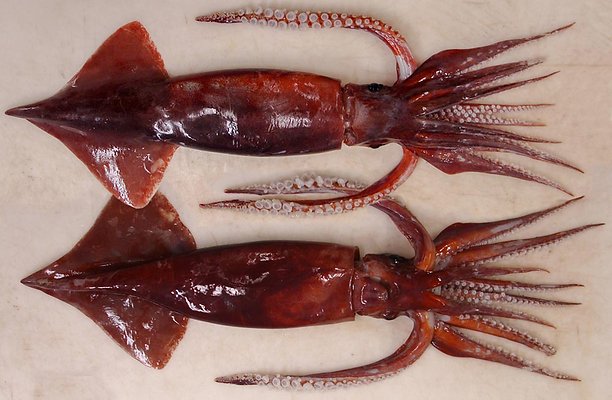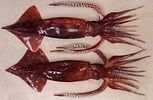Todarodes angolensis
Introduction
Todarodes angolensis has historically been confused with Todarodes filippovae. However,T. angolensis seems to primarily occupy waters over the slope of Islands and continents while T. filippovae occupies waters of the open ocean in the
Brief diagnosis (from Dunning and Wormuth, 1998):
A Todarodes with ...
- 14-18 transverse sucker rows on manus.
- 13-16 teeth in sucker ring of largest manus sucker.
- diameter of largest manus sucker at 2.0 - 2.6 mm.
Table comparing all species is found on the Todarodes page.
Distribution
Type locality of T. angolensis: South Atlantic off Angola at about 13°10'S, 12°50'E. There is uncertainty in the distribution of this species as its systematic history has confused its separation from T. filippovae. These two species are sympatric in the Tasman Sea (Dunning and Wormuth, 1998) at least.
Off South Africa T. angolensis, "is an indicator species for the upper slope benthic habitat. During daylight adult squids occur only near the bottom" (Jereb and Roper, 2010, p. 325). Rodhouse, 1998,
References
Dunning, M. C. and J. H. Wormuth. 1998. The ommastrephid squid genus Todarodes: A review of systematics, distribution, and biology (Cephalopoda: Teuthoidea). . Smithsonian Contributions to Zoology, No. 586: 385-391.
Rodhouse, P. D. 1998. Todarodes filippovae in the Southern Ocean: an appraisal for exploitation and management. p. 207-215, In: Large Pelagic Squids, T. Okutani (Ed.) Japan Marine Fishery Resources Research Center, Tokyo, 269 pp.
Title Illustrations

| Scientific Name | Todarodes angolensis |
|---|---|
| Location | NewZealand sub-Antarctic at 49.48°S, 174.44°E. Caught in a bottom trawl at 646 m depth. |
| Comments | Title photograph shows two views of the same specimen. |
| Acknowledgements | National Institute of Water & Atmospheric Research (NIWA) |
| Identified By | Darren Stevens |
| Sex | Female (?) |
| View | Dorsal (top), ventral (bottom) |
| Size | 474 mm ML |
| Collection | NIWA |
| Image Use |
 This media file is licensed under the Creative Commons Attribution License - Version 3.0. This media file is licensed under the Creative Commons Attribution License - Version 3.0.
|
| Copyright | © Darren Stevens |
About This Page
Page copyright © 2016
All Rights Reserved.
- First online 27 February 2016
- Content changed 27 February 2016
Citing this page:
Tree of Life Web Project. 2016. Todarodes angolensis . Version 27 February 2016 (temporary). http://tolweb.org/Todarodes_angolensis/77452/2016.02.27 in The Tree of Life Web Project, http://tolweb.org/









 Go to quick links
Go to quick search
Go to navigation for this section of the ToL site
Go to detailed links for the ToL site
Go to quick links
Go to quick search
Go to navigation for this section of the ToL site
Go to detailed links for the ToL site